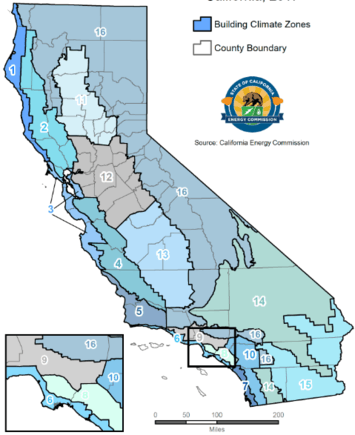California Energy Code
The California Energy Code (also titled The Energy Efficiency Standards for Residential and Non-residential Buildings) is the sixth section of the California Building Standards Code. The code was created by the California Building Standards Commission in 1978 in response to a legislative mandate to reduce California's energy consumption. These standards are updated periodically by the California Energy Commission. The code includes energy conservation standards applicable to most buildings throughout California.[1]
History
California was the first state to implement minimum energy efficiency standards in 1974. It was the first to establish an energy regulation commission – the California Energy Commission. These regulations and codes have been in effect since 1974. California has the lowest per capita energy consumption in the US,[2]
2008 Code
Updated standards were adopted on April 23, 2008, and the Building Standards Commission approved them for publication on September 11, 2008. The 2008 Residential Compliance Manual was adopted by the Commission on December 17, 2008, and the 2008 non-residential Compliance Manual was adopted on January 14, 2009.
The 2008 changes to the Building Energy Efficiency Standards were intended to:
- Provide California with an adequate, reasonably-priced, and environmentally-sound supply of energy.
- Respond to Assembly Bill 32, the Global Warming Solutions Act of 2006, which mandated that California reduce its greenhouse gas emissions to 1990 levels by 2020.
- Meet the West Coast Governors' Global Warming Initiative commitment to include energy efficiency measures into state building codes.
- Meet the Executive Order in the Green Building Initiative to improve the energy efficiency of non-residential buildings.
California governor Arnold Schwarzenegger challenged the CEC in 2008 to attain Zero Net Energy by 2020 for California Residential Building Code and issued a similar challenge for California's non-residential Building Code by 2030.
Purpose
The code's purpose is to advance the state's energy policy, develop renewable energy sources and prepare for energy emergencies. The codes are divided into residential and non-residential sections.
Structure
The three general parts, which include all the responsibilities and criteria of the standards, are:
- Mandatory Requirements
- Performance Standards
- Prescriptive Standards
All buildings must follow the mandatory requirements. Performance standards vary by the building location and type.
These parts are designed to accomplish the following:
- Forecast future energy need
- Support energy and technology research
- Develop renewable energy resources
- Develop renewable transportation fuels and technologies
Climate Zones
California has 16 different climate zones. Standards vary based on zone:

2019 Code
The 2019 California Energy Code (Building Energy Efficiency Standards) become effective on January 1, 2020. It focuses on such areas such as residential photovoltaic systems, thermal envelope standards and non-residential lighting requirements.
Homes built under this code are about 53% more energy efficient than those built to comply with the 2016 Energy Code[3]. Non-residential buildings were expected to use about 30% less electricity due to lighting upgrades. Residential home owners were expected to save $80 per month on heating, cooling and lighting, and improve indoor air quality. This code provides a market for "smart" technologies.[4]
The 2019 Code added photovoltaic system requirements for low-rise residential buildings. Exceptions grant a reduction in size for photo-voltaic systems.[5]
The 2019 Code has simpler non-residential forms and reduces their number from 47 forms to 10. Each building component has one form per category:
- Electric Power Distribution
- Outdoor Lighting
- Indoor Lighting
- Sign Lighting
- Solar Ready
- Commissioning
- Thermal Envelope
- Covered Processes
- Mechanical
- Water Heating
See also
References
- "2016 California Energy Code, Title 24, Part 6". shop.iccsafe.org. Retrieved 2018-09-08.
- "Power Hungry".
- "THE CALIFORNIA ENERGY COMMISSION | EFFICIENCY DIVISION 2019: Building Energy Efficiency Standards" (PDF). March 2018. Retrieved 25 April 2019.
- "California Energy Code 2019 – Energy commission adopts standards requiring solar systems for new homes, First in Nation".
- "Blueprint California Energy Commission-Issue 123" (PDF).